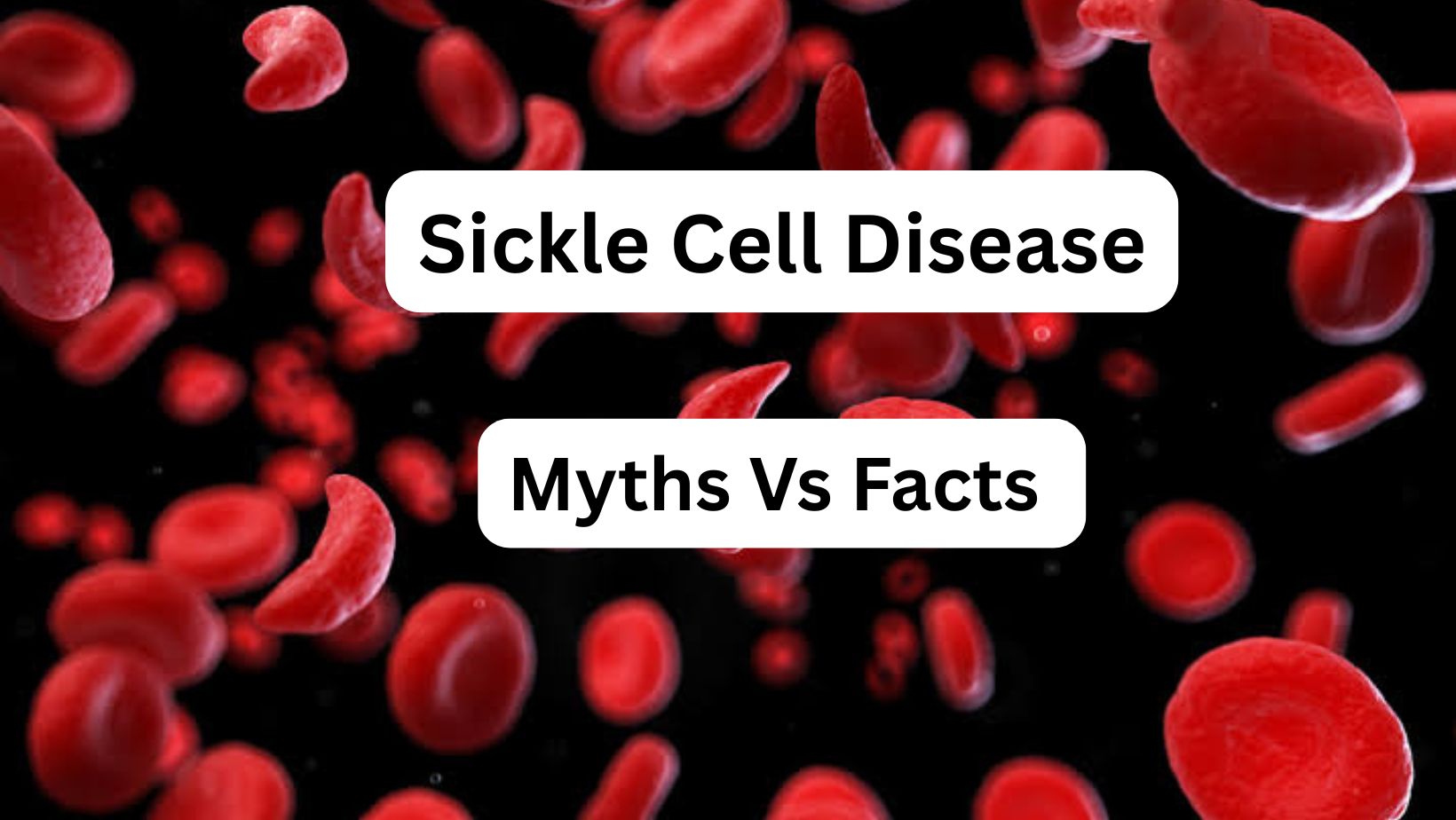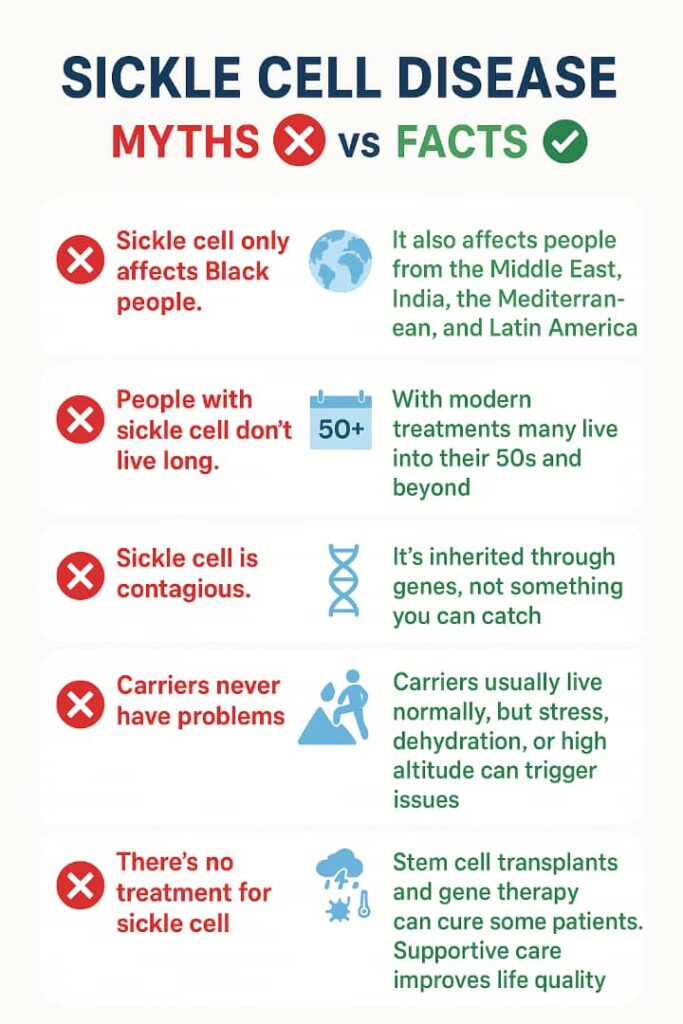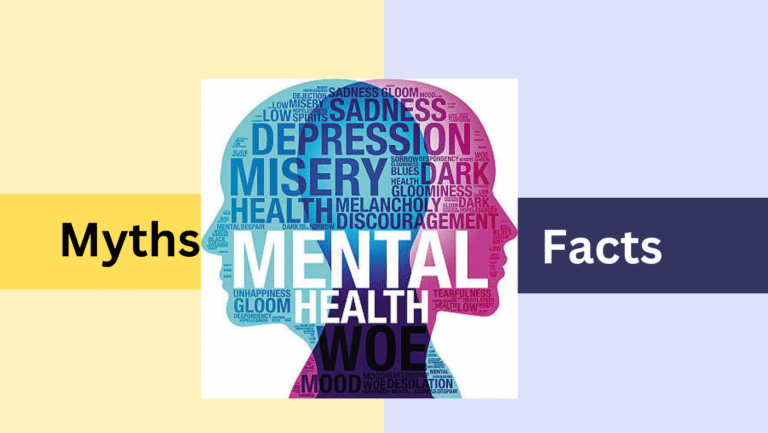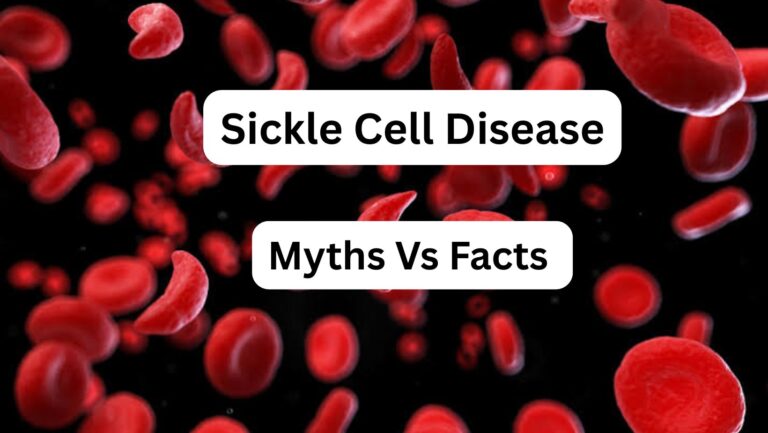
🧠 Sickle Cell Disease: Myths vs Facts You Must Know
Sickle cell disease (SCD) is one of the most misunderstood genetic conditions in the world. Despite affecting millions globally, myths and misinformation continue to cloud public understanding, leading to stigma, delayed diagnosis, and inadequate care. In this blog post, we’ll bust the most common myths and reveal the facts behind this complex blood disorder.
🌍 Myth 1: Sickle Cell Disease Only Affects Black People.
Fact: While SCD is most prevalent among people of African descent, it also affects individuals from the Mediterranean, Middle East, India, and Latin America. The disease is linked to regions where malaria is common, not race. Anyone can carry the sickle cell trait and pass it on to their children.
🧬 Myth 2: Sickle Cell Disease Is Contagious
Fact: SCD is a genetic condition, not an infectious one. It is inherited when both parents carry the sickle cell trait. You cannot “catch” sickle cell disease through blood contact, touch, or proximity.
💉 Myth 3: Sickle Cell Trait Is the Same as Sickle Cell Disease
Fact: The sickle cell trait means a person carries one copy of the abnormal gene but usually doesn’t show symptoms. Sickle cell disease occurs when a person inherits two copies—one from each parent. Trait carriers can live normal lives but may pass the gene to their children.
Read also Can Herbs Cure PCOS? Discover The Best Herbal Remedies
🔥 Myth 4: People With SCD Are Lazy
Fact: This harmful stereotype stems from misunderstanding the chronic pain and fatigue that SCD patients endure. Pain crises can be debilitating, and fatigue is a common symptom due to reduced oxygen flow. Many patients are hardworking individuals who simply need accommodations.

🧠 Myth 5: SCD Patients Don’t Live Past Childhood
Fact: With modern medicine, many people with SCD live into their 40s, 50s, and beyond. Early diagnosis, regular checkups, and proper management can significantly improve life expectancy. In Nigeria, awareness and access to care are improving, but more work is needed.
🦠 Myth 6: SCD Patients Are Immune to Malaria
Fact: People with sickle cell disease are not immune to malaria. While carriers of the trait may have some protection, those with full-blown SCD are vulnerable and should take antimalarial precautions.
🩺 Myth 7: SCD Is Always Visible.
Fact: SCD is often an invisible illness. Many patients may not show outward signs but suffer internally from pain, organ damage, and fatigue. Judging someone’s health based on appearance is misleading and unfair.
🧊 Myth 8: Cold Weather Causes Sickle Cell Crises
Fact: While cold weather can trigger pain crises due to blood vessel constriction, it’s not the sole cause. Dehydration, stress, infections, and high altitudes can also lead to crises. Patients must manage multiple environmental and lifestyle factors.
🧪 Myth 9: There’s No Treatment for SCD
Fact: While there’s no universal cure, treatments like hydroxyurea, blood transfusions, and bone marrow transplants can help manage symptoms. Gene therapy is also showing promise in clinical trials. Early intervention is key to improving quality of life.
🧑⚕️ Myth 10: SCD Patients Can’t Have Children.
Fact: Many people with SCD can have children, though pregnancy carries risks. With proper medical supervision, family planning, and genetic counseling, patients can make informed decisions about parenthood.
—
🇳🇬 Sickle Cell in Nigeria: A Call for Awareness
Nigeria has the highest burden of sickle cell disease globally, with over 150,000 babies born annually with SCD. Despite this, awareness remains low, and myths persist. Public education, early screening, and community support are essential to combat stigma and improve outcomes.
💡 What You Can Do
– Get tested: Know your genotype before marriage or having children.
– Educate others: Share facts, not fear.
– Support organizations: Donate or volunteer with sickle cell foundations.
– Advocate for policy: Push for better healthcare access and genetic counseling.
📚 Final Thoughts.
Sickle cell disease is not a curse, a punishment, or a death sentence. It’s a manageable condition that requires compassion, education, and support. By debunking myths and spreading facts, we can create a more inclusive and informed society for sickle cell warriors everywhere.
📌 References
1. McGee, B. T., Attell, B. K., Marton, J., Harris, A., Alfrey, B., Cohen, L., & Snyder, A. B. (2025). Changes in acute care use among people with sickle cell disease after adoption of a prescription drug monitoring program. Blood Advances. https://doi.org/10.1182/bloodadvances.2024013594
2. Miller, J. I., Hassell, K. L., Kellar-Guenther, Y., Quesada, S., West, R., & Sontag, M. (2024). The prevalence of sickle cell disease in Colorado and methodologies of the Colorado Sickle Cell Data Collection Program: Public health surveillance study. JMIR Public Health and Surveillance, 10, e64995. https://doi.org/10.2196/64995
3. Shi, J. S., Sutaria, A., Lakshmanan, S., Attell, B., Zhou, M., Tang, A., Eckman, J., & Snyder, A. (2024). Immunization adherence among children with sickle cell disease and sickle cell trait: Results of a population-based study. Pediatric Blood & Cancer, 71(7), e31042. https://doi.org/10.1002/pbc.31042
4. Peng, H. K., Dombkowski, K. J., Plegue, M. A., Latta, K., Malosh, R., Creary, M. S., & Reeves, S. L. (2024). COVID-19 immunization coverage among people with sickle cell disease. JAMA Network Open, 7(1), e2351618. https://doi.org/10.1001/jamanetworkopen.2023.51618
5. Young, A. J., Maresh, A., Pope, S., Blaylark, R., Lakshmanan, S., Stephens, L., … & Desai, J. (2024). Improving the lives of people with sickle cell disease: Community organizations and epidemiologists working together. Progress in Community Health Partnerships, 18(3), 371–380. https://doi.org/10.1353/cpr.2024.0037
6. Anderson, A. T., Mack, W. J., Horiuchi, S. S., Paulukonis, S., Zhou, M., Snyder, A. B., … & Freed, G. (2024). National quality indicators in pediatric sickle cell anemia. Pediatrics, 153(4), e2022060804. https://doi.org/10.1542/peds.2022-060804
7. Singh, A., Brousseau, D. C., Dasgupta, M., Shet, A. S., Field, J. J., & Brandow, A. M. (2024). Acute care utilization among individuals with sickle cell disease and related cardiopulmonary and renal complications. PLoS ONE, 19(4), e0297469. https://doi.org/10.1371/journal.pone.0297469
Disclaimer
The content in our articles is not meant to substitute a personal consultation with a qualified healthcare professional and should not be considered medical advice.







